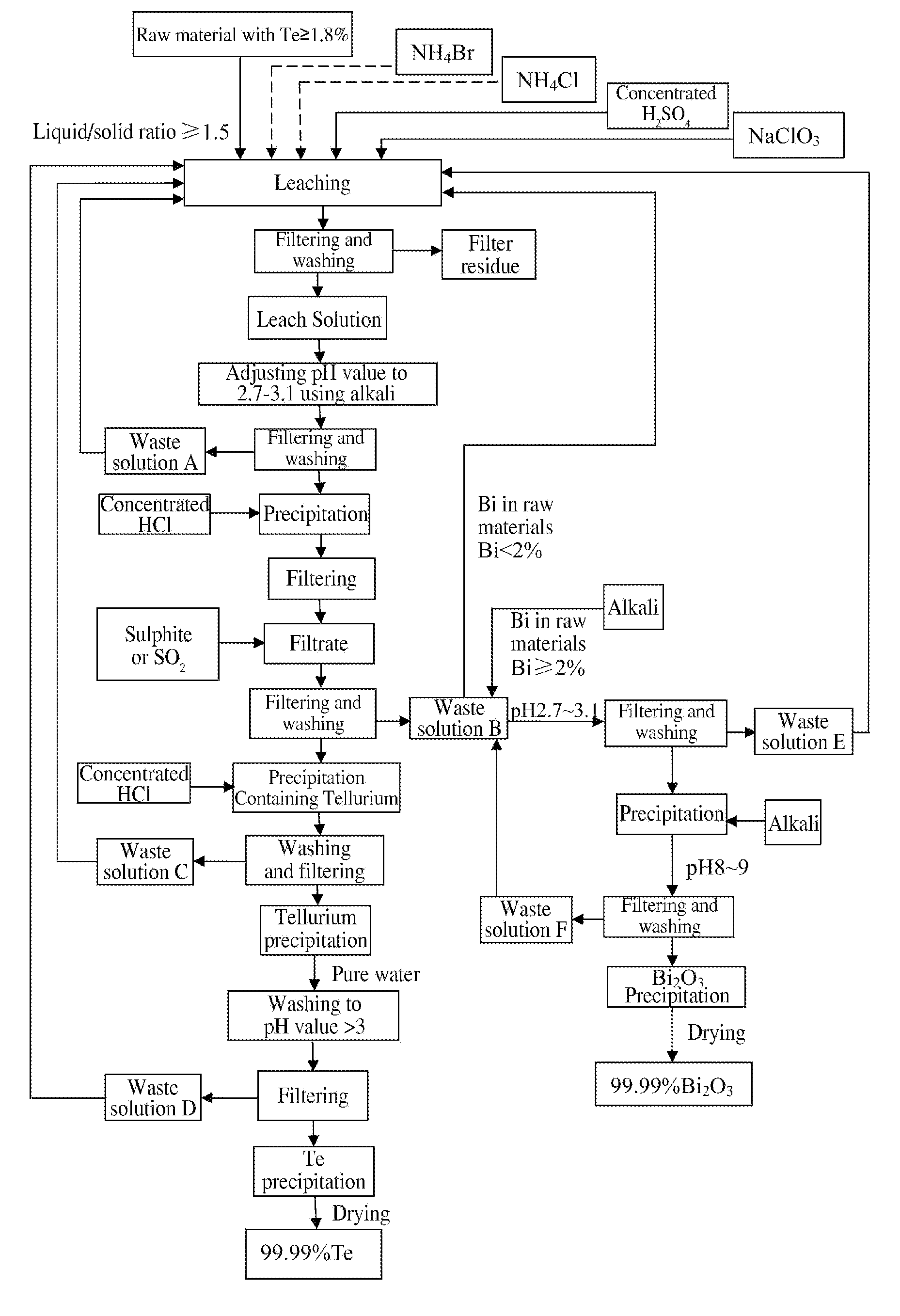Method of Extracting Te and Bismuth Oxide and Recovering Byproducts
- Summary
- Abstract
- Description
- Claims
- Application Information
AI Technical Summary
Benefits of technology
Problems solved by technology
Method used
Image
Examples
example 1
[0028]3 tons of tetradymites are crushed to 80 meshes, and the content of major elements in the raw material is shown in the table below:
NameTeBiCuFePbCaSAlSiO2CoNiSecontent %5.89.121.815.50.01917.44.114.087.440.00590.00380.0052
[0029]Liquid-solid ratio is 2, and leaching condition and results are shown in the table below:
AmountAmountAmountofofConcentrated H2SO4NaClO3TeBiof liquidNH4ClNH4BrLeachAmountLeachLeachAmountLeachLeachResidualleachleachaddedaddedaddedtimeaddedtimetemp.addedtimetemp.acidityraterate6 m3525 kg60 kg3 h3 T3 h65° C.150 kg5 h95° C.1.5 N98.3%98.6%H2O
[0030]As shown in the above table, during leaching, adding 6m3 of H2O into 3 tons of raw material followed by adding 525 kg NH4Cl and 60 kg NH4Br, leaching for 3 h at ambient temperature; then adding 3 tons of concentrated H2SO4 and leaching for another 3 h with the temperature spontaneously rising to 65° C.; then adding 150 kg NaClO3 and leaching for 5 h under stirring with the temperature spontaneously rising to 95° C.;...
example 2
[0034]3 tons of tetradymites are crushed to 100 meshes, and the content of major elements in the raw material is shown in the table below:
NameTeBiCuFePbCaSAlSiO2CoNiSecontent %6.619.632.0316.20.017716.83.924.517.540.00540.00450.005
[0035]Liquid-solid ratio is 2, and leaching condition and results are shown in the table below:
AmountAmountAmountofofConcentrated H2SO4NaClO3TeBiof liquidNH4ClNH4BrLeachAmountLeachLeachAmountLeachLeachResidualleachleachaddedaddedaddedtimeaddedtimetemp.addedtimetemp.acidityraterate6 m3230 kg48 kg2 h2.9 T2.5 h60° C.150 kg4 h90° C.1.4 N99.1%99.2%wastesolution
[0036]As shown in the above table, adding 6m3 of waste solution separated from Example 1 into 3 tons of raw material followed by adding 230 kg NH4Cl and 48 kg NH4Br, leaching for 2 h at ambient temperature; then adding 2.9 tons of concentrated H2SO4 and leaching for another 2.5 h with the temperature spontaneously rising to 60° C.; then adding 150 kg NaClO3 and leaching for 4h under stirring while the tem...
example 3
[0042]3 tons of tetradymites are crushed to 100 meshes, and the content of major elements in the raw material is shown in the table below:
NameTeBiCuFePbCaSAlSiO2CoNiSeContent %6.99.822.315.40.01816.34.324.757.710.0040.00510.0043
[0043]The waste solution separated from example 2 is added at a liquid-solid ratio of 2, and leaching condition and results are shown in the table below:
AmountAmountAmountofofofConcentrated H2SO4NaClO3TeBiliquidNH4ClNH4BrLeachAmountLeachLeachAmountLeachLeachResidualleachleachaddedaddedaddedtimeaddedtimetemp.addedtimetemp.acidityraterate6 m3225 kg60 kg2 h2.86 T1 h45° C.150 kg4 h95° C.1.2 N99.7%99.6%wastesolution
[0044]Detailed description for procedures which are the same as Example 2 is omitted herein. Full analysis data of the leach solution and leach residue are shown in the table below:
NameTeBiCuFePbCaMgAgAlSiO2CoNiSeLeach solution g / l31.8544.927.125.10.00350.186.030.0316.31.60.0410.450.25Leach residue %0.0230.0210.1115.50.001616.33.50.00184.253.830.00010.0...
PUM
| Property | Measurement | Unit |
|---|---|---|
| Temperature | aaaaa | aaaaa |
| Temperature | aaaaa | aaaaa |
| Temperature | aaaaa | aaaaa |
Abstract
Description
Claims
Application Information
 Login to View More
Login to View More - R&D
- Intellectual Property
- Life Sciences
- Materials
- Tech Scout
- Unparalleled Data Quality
- Higher Quality Content
- 60% Fewer Hallucinations
Browse by: Latest US Patents, China's latest patents, Technical Efficacy Thesaurus, Application Domain, Technology Topic, Popular Technical Reports.
© 2025 PatSnap. All rights reserved.Legal|Privacy policy|Modern Slavery Act Transparency Statement|Sitemap|About US| Contact US: help@patsnap.com


